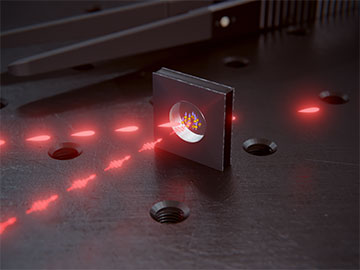Researchers in Switzerland have developed a millimeter-sized silicon-glass cell filled with rubidium vapor that can store and retrieve quantum data in the form of light pulses. They foresee about 1,000 such devices being built from just one silicon wafer. [Image: University of Basel, Department of Physics/Scixel]
Quantum networks promise everything from ultra-secure communications to distributed quantum computing. But sending quantum information over long distances is exceedingly difficult and generally calls for very advanced memory to buffer data while setting up entangled links.
Researchers in Switzerland report that they have now shown how to develop a memory made from a vapor of rubidium atoms housed in a tiny micro-electromechanical system (Phys. Rev. Lett., doi: 10.1103/PhysRevLett.131.260801). They envisage such memories being mass produced on silicon wafers, potentially enabling data transfer on continental scales.
Establishing entanglement
Both classical and quantum data can be transferred by encoding them in light pulses and sending the pulses down optical fiber. But the problem of fiber's attenuation creates a much bigger headache for the latter. Whereas signals traveling across the internet today can be boosted via straightforward amplification, the no-cloning theorem prevents a similar solution for data in a would-be quantum internet.
Devices known as quantum repeaters provide a way out. The idea is to connect distant parties by establishing an entangled link between them. That link is broken down into a series of equal-length subsections, each short enough to limit attenuation to acceptable levels. Entanglement is initially established between the ends of each subsection, and then it is progressively extended by using quantum repeaters to enact a process known as entanglement swapping that connects progressively larger chunks of the link together.
Quantum repeaters use beam splitters to establish contact separately with two end stations. Because that contact is not guaranteed at the first time of asking, they need memories to store the quantum states generated by each half of the system just in case the other isn't ready.
Rubidium vapor cell
In the latest work, Roberto Mottola, Philipp Treutlein and Gianni Buser at the University of Basel have demonstrated a memory that would work together with a source of single photons at each end of an entangled link. The memory functions by transferring the quantum state from each photon to an ensemble of rubidium-87 atoms and then emitting a photon in the same state after a specific time has elapsed.
The memory functions by transferring the quantum state from each photon to an ensemble of rubidium-87 atoms and then emitting a photon in the same state after a specific time has elapsed.
The researchers' device consists of a vapor of rubidium atoms inside a cell just 5 mm in diameter and 2 mm thick, which colleagues at the University of Neuchâtel, also in Switzerland, etched from a silicon wafer and capped with two pieces of glass. They then placed the cell inside a roughly 1-tesla magnetic field to separate out the hyperfine levels of the atoms' ground and first excited state so as to enable a clean, three-level system suitable for quantum memory―and suited in particular to the single photons emitted by gallium-arsenide quantum dots.
They used infrared laser beams to heat the rubidium gas to around 90°C—increasing optical depth and enhancing interactions between photonic and matter qubits—and used a pump laser to prepare the atoms in the correct ground state. They then fired in a control pulse ―to map photonic and atomic excitations to one another―together with a signal pulse attenuated to approximate an incoming single photon. Finally, the researchers applied a second control pulse to retrieve the signal photon, measuring the latter using a superconducting detector. The whole process was repeated automatically 300,000 times per second for about a minute at a time.
Aiming at mass production
The team found that, when storing data for about 80 nanoseconds, about 3% of the signal pulses yielded corresponding signals in the detector. By subtracting all other losses in the system, the scientists worked out that the memory itself has an efficiency of nearly 25%, which they argue is a good result given their still-limited optical depth. The signal-to-noise ratio was about 8.
Mottola and colleagues intend to test their memory with a true source of single photons, such as a gallium-arsenide quantum dot, and then aim to have around 1,000 copies of the same memory fabricated from a single silicon wafer. Before they do that, however, they first plan to make a series of improvements to the system, including boosting the optical depth by either lengthening the cell or sending the light on a more circuitous route through the cell.
The researchers also intend to add anti-relaxation coatings to the cell walls to preserve the spin of atoms bouncing around a narrower cell―which should enhance interactions between atoms and laser beams, extending the storage time.


